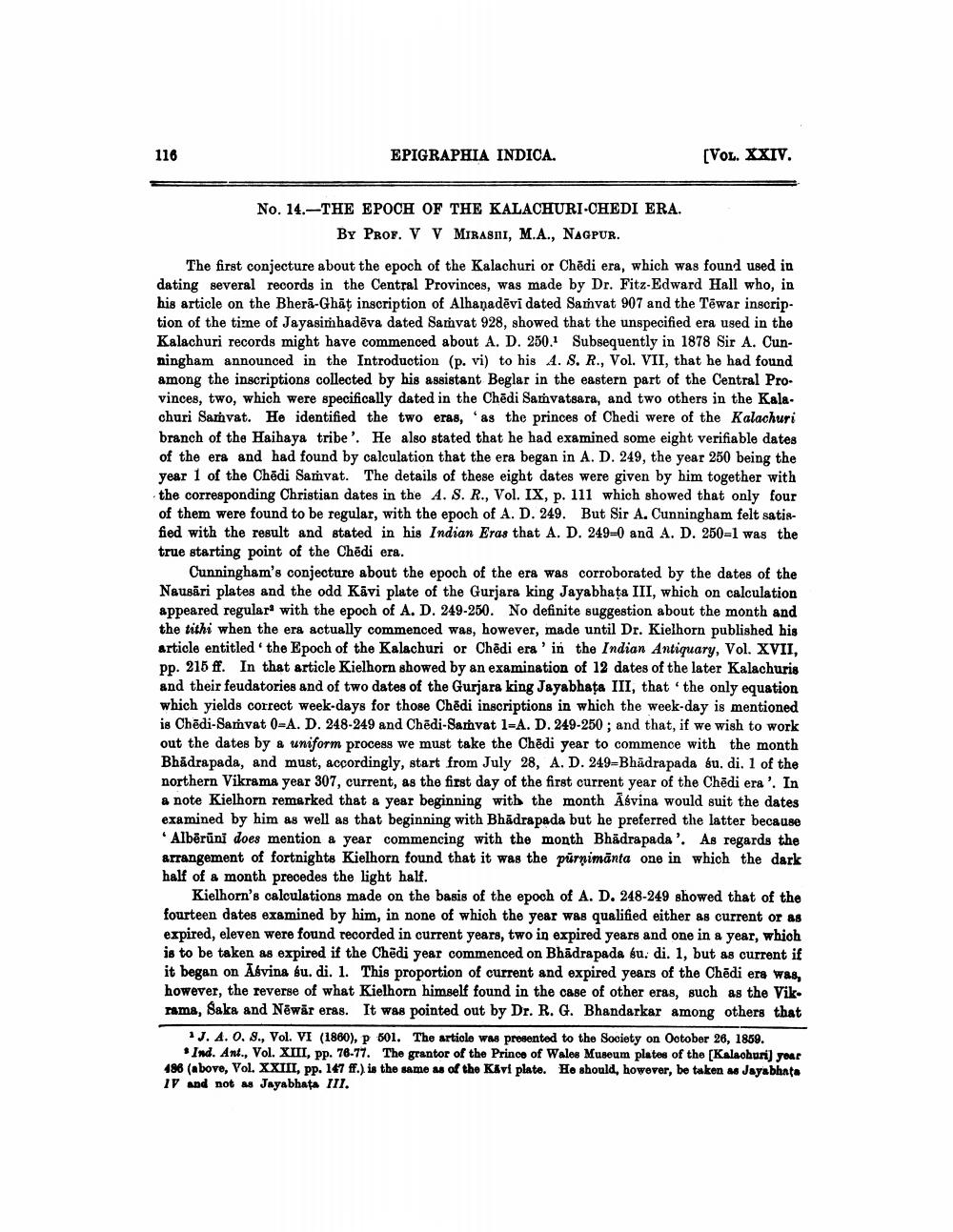________________
116
EPIGRAPHIA INDICA.
[VOL. XXIV.
No. 14.-THE EPOCH OF THE KALACHURI-CHEDI ERA.
BY PROF. V V MIRASILI, M.A., NAGPUR.
The first conjecture about the epoch of the Kalachuri or Chēdi era, which was found used in dating several records in the Central Provinces, was made by Dr. Fitz-Edward Hall who, in his article on the Bherā-Ghāt inscription of Alhaņadēvi dated Samvat 907 and the Tēwar inscription of the time of Jayasimhadēva dated Samvat 928, showed that the unspecified era used in the Kalachuri records might have commenced about A. D. 250. Subsequently in 1878 Sir A. Cunningham announced in the Introduction (p. vi) to his A. S. R., Vol. VII, that he had found among the inscriptions collected by his assistant Beglar in the eastern part of the Central Pro. vinces, two, which were specifically dated in the Chēdi Samvatsara, and two others in the Kala. churi Samvat. He identified the two eras, as the princes of Chedi were of the Kalachuri branch of the Haihaya tribe'. He also stated that he had examined some eight verifiable dates of the era and had found by calculation that the era began in A. D. 249, the year 250 being the year 1 of the Chēdi Samvat. The details of these eight dates were given by him together with the corresponding Christian dates in the A. S. R., Vol. IX, p. 111 which showed that only four of them were found to be regular, with the epoch of A. D. 249. But Sir A. Cunningham felt satisfied with the result and stated in his Indian Eras that A. D. 249-0) and A. D. 250-1 was the true starting point of the Chēdi era.
Cunningham's conjecture about the epoch of the era was corroborated by the dates of the Nausāri plates and the odd Kävi plate of the Gurjara king Jayabhata III, which on calculation appeared regular with the epoch of A. D. 249-250. No definite suggestion about the month and the tithi when the era actually commenced was, however, made until Dr. Kielhorn published his article entitled the Epoch of the Kalachuri or Chēdi era ' in the Indian Antiquary, Vol. XVII, pp. 215 ff. In that article Kielhorn showed by an examination of 12 dates of the later Kalachuris and their feudatories and of two dates of the Gurjara king Jayabhata III, that the only equation which yields correct week-days for those Chēdi inscriptions in which the week-day is mentioned is Chēdi-Samvat 0-A. D. 248-249 and Chēdi-Samvat 1-A. D. 249-250; and that, if we wish to work out the dates by a uniform process we must take the Chēdi year to commence with the month Bhadrapada, and must, accordingly, start from July 28, A. D. 249-Bhadrapada bu, di. 1 of the northern Vikrama year 307, current, as the first day of the first current year of the Chēdi era'. In a note Kielhorn remarked that a year beginning with the month Ābvina would suit the dates examined by him as well as that beginning with Bhādrapada but he preferred the latter because
Albērūni does mention a year commencing with the month Bhādrapada'. As regards the arrangement of fortnights Kielhorn found that it was the purnimānta one in which the dark half of a month precedes the light half.
Kielhorn's calculations made on the basis of the epoch of A. D. 248-249 showed that of the fourteen dates examined by him, in none of which the year was qualified either as current or as expired, eleven were found recorded in current years, two in expired years and one in a year, which is to be taken as expired if the Chēdi year commenced on Bhādrapada bu. di. 1, but as current if it began on Abvina su. di. 1. This proportion of current and expired years of the Chēdi era was, however, the reverse of what Kielhorn himself found in the case of other eras, such as the Vik. rama, Saka and Nēwär eras. It was pointed out by Dr. R. G. Bhandarkar among others that
1J.A.0. ., Vol. VI (1860), p 501. The article was presented to the Society on October 26, 1869.
$ Ind. Ant., Vol. XIII, pp. 76-77. The grantor of the Prince of Wales Museum plates of the (Kalaohuri) your 486 (above, Vol. XXIII, pp. 147 ff.) is the same as of the Kavi plate. Ho should, however, be taken as Jayabhnta IV and not as Jayabhata III.




